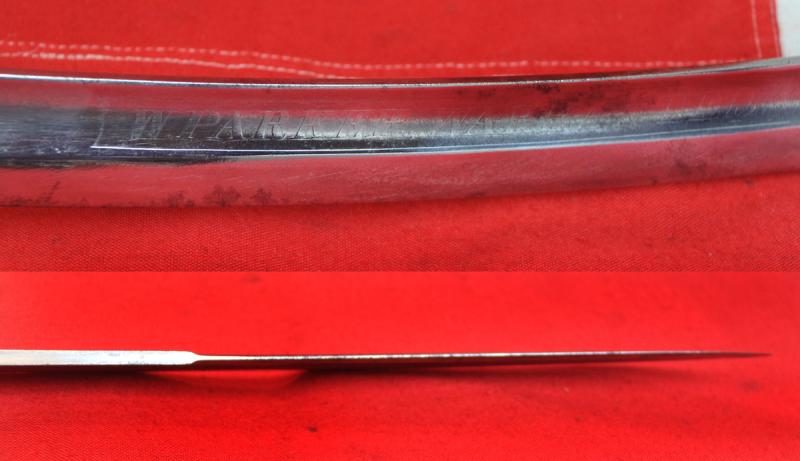A Simply Superb 'Parker Warranted' Constabulary Police Cutlass With Large Etched W. Parker Makers Panel
Very good condition overall. Blade with large W. Parker Warranted panel. The leather hide scabbard has gained a breathtaking bright full polish patina worthy of a King's guardsman's leather boots.
Brass D hilt with sharkskin bound wooden grip, single brass mount to the leather scabbard that has a little shrinkage. the blade is bright an supperb with just minor age staining and a fabulous large panel of etching by the maker W. Parker of Holborn, stating 'W.Parker. Warranted' one of the best looking examples we have seen in quite sometime, especially with Parker's large etched name & Warranted panel on the blade face, which is very rarely seen
W. Parker was also one of England's pre-eminent gunmakers makers of the 19th century, William Parker of 233 High Holborn, was gun maker to Prince Edward, to King William IV (1830-1837) and the Duke of Kent. As a gun maker William Parker was a well known for producing a range of weapons from standard issue items to fine duelling pistols. He later started to produce truncheons and other articles such as handcuffs, swords and rattles.
Current Police Officers, on late night duty, do, what is now very commonly called the 'graveyard shift'. This old English term, is now used worldwide by almost all professions that has a night duty, it is in fact derived from the early days of the British constabulary force, when undertaking the late night duty of patrolling graveyards, which was called by the Victorian constabulary, the 'graveyard shift'. It was a regular patrol made in order to prevent body-snatchers from defiling late burials, and the stealing bodies, for medical experimentation. This was however, a highly dangerous part of Victorian policing, as grave robbing was a capital crime, so, the police constables were armed with these swords to protect them from grave assault. These swords were also issued in case of riot, and in various times for general service wear as well.
Metropolitan Police patrols took to the streets on 29 September 1829, despite resistance from certain elements of the community who saw them to be a threat to civil liberties. The initial force consisted of two Commissioners, eight Superintendents, 20 Inspectors, 88 Sergeants and 895 Constables. Patrolling the streets within a seven-mile (11 km) radius of Charing Cross, in order to prevent crime and pursue offenders.
Between 1829 and 1830, 17 local divisions each with a central police station were established, with each division assigned a letter. These divisions were:
A (Whitehall)
B (Westminstera)
C (St James's)
D (Marylebone)
E (Holborn)
F (Covent Garden)
G (Finsbury)
H (Whitechapel)
K (Stepneyb)
L (Lambeth)
M (Southwark)
N (Islington)
P (Camberwell)
R (Greenwich)
S (Hampstead)
T (Kensingtonc)
V (Wandsworth)
On 28 June 1830, Constable Joseph Grantham became the first member of the force to be killed in the line of duty, an incident described by the Coroner's Inquest as "justifiable homicide". Other indications of the Constabulary's unpopularity of the time, were such nicknames as 'Raw Lobsters', 'Blue Devils' and 'Peel's Bloody Gang'. Officers were physically assaulted, others impaled, blinded, and on one occasion held down while a vehicle was driven over them.
Code: 24819
645.00 GBP








